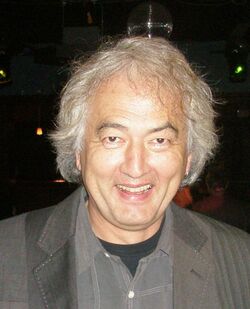John Harris (physicist)
Topic: Biography
 From HandWiki - Reading time: 4 min
From HandWiki - Reading time: 4 min
John Harris | |
|---|---|
 | |
| Born | March 14, 1950 (age 74) |
| Nationality | |
| Alma mater | Stony Brook University |
| Known for | Relativistic heavy ion collisions |
| Awards | Humboldt Prize Fellow of the American Physical Society Top 40 Distinguished Alumni, on the occasion of the 40th Anniversary of Stony Brook University |
| Scientific career | |
| Fields | Physics, Nuclear Physics |
| Institutions | Lawrence Berkeley National Laboratory Yale University |
| Doctoral advisor | Robert L. McGrath |
| Other academic advisors | Peter Paul, Peter Wurm, Linwood Lee, Peter Braun-Munzinger, Lee Schroeder, Reinhard Stock |
John W. Harris (born March 14, 1950) is an American experimental high energy nuclear physicist and Professor of Physics at Yale University. He was the founding spokesperson for the STAR collaboration at the Relativistic Heavy Ion Collider.
Nuclear Physics Career
After obtaining a Bachelor of Science, with Distinction, from the University of Washington, John Harris started his career at the Stony Brook University (then known as State University of New York at Stony Brook), where he completed his Ph.D. in experimental nuclear physics in 1978.[1]
Lawrence Berkeley National Laboratory
After his Ph.D. Dr. Harris went to Lawrence Berkeley National Laboratory (LBNL) in Berkeley, California, to conduct his post-doctoral work in high-energy nuclear physics from 1978 to 1979. After working as a senior guest scientist at the Gesellschaft für Schwerionenforschung in Darmstadt, Germany, from 1980 to 1984, he returned to LBNL in 1984 and was appointed divisional fellow in the Nuclear Science Division. He became staff senior scientist in 1989 and served in this role until 1995. During his time at LBNL he was a collaborator in the NA35 experiment at CERN (1985–1991), spokesman of the Bevalac CCD-Streamer Chamber Experiments at LBL (1986–1990), CERN NA35 Project Leader in Nuclear Science Division at LBL (1990–1991), RHIC project leader in Nuclear Science Division at LBL and deputy program head of the Relativistic Nuclear Collisions Program (1990–1996). His most significant work from this period focused on compression effects in nucleus-nucleus collisions,[2] pion production in high energy nucleus-nucleus Collisions,[3] and on directed and elliptic flow in Pb+Pb collisions at the CERN SPS.[4]
Yale University
In 1996, Dr. Harris joined the faculty of Yale University in New Haven, Connecticut, as a tenured professor of physics. From 2008 to 2010 he served as the director of the Wright Nuclear Structure Laboratory at Yale University.[5]
STAR Collaboration
The STAR collaboration, which is carrying out experiments at the Relativistic Heavy Ion Collider (RHIC) at Brookhaven National Laboratory on Long Island, New York, was founded in 1991, and John Harris served as its first spokesman from 1991 to 2002. He also served as the acting project manager from 1991 to 1992. At present, he is still a member of this collaboration. Among the most important discoveries by the STAR collaboration is the "perfect liquid".[6]
ALICE Collaboration
John Harris joined the ALICE (A Large Ion Collider Experiment) collaboration at the CERN Large Hadron Collider in 2006 and became the national coordinator for ALICE-USA Collaboration at the Large Hadron Collider. Since 2009 he has been a member of the ALICE Physics Board.[7][8] Since 2010 he is also Deputy Chair of the ALICE Collaboration Board.[9]
Service to the Nuclear Physics Community
- Associate Editor of Nuclear Physics (Intermediate Energy), 1991–1995
- Member of the U.S. Nuclear Science Advisory Committee (NSAC), 1993–1996
- Co-convener for "Town Meeting on Intermediate and High Energy Heavy Ions", NSAC Long Range Planning, 1995
- NSAC Long Range Plan Working Group, 1995–1996
- Member of the organizing committees of the annual Winter Workshop on Nuclear Dynamics, since 1992.
Honors
Harris received the Nuclear Science Divisional Fellowship, Lawrence Berkeley Laboratory, U.C. Berkeley, in 1984, the Alexander von Humboldt Fellowship of the Federal Republic of Germany in 1986, and the Lawrence Berkeley Laboratory Performance Achievement Award in 1993. Harris was awarded the Alexander-von-Humboldt Foundation Distinguished Senior U.S. Scientist Award (Humboldt Prize, Humboldt-Forschungspreis für Naturwissenschafler aus den USA) in 1994. He was elected Fellow of the American Physical Society in 1996. In 2002, on the occasion of the 40th Anniversary of Stony Brook University, he was designated a Top 40 Distinguished Alumni.
Scientific Publications
Textbooks
- Harris, J.W.; Stöcker, H. (1998). Handbook of Mathematics and Computational Science. Springer - New York.
- Benenson, W.; Harris, J.W.; Stöcker, H. (2002). Handbook of Physics. Springer - New York.
References
- ↑ "John Harris' official CV". 2012. http://star.physics.yale.edu/johnharris/CV.html.
- ↑ Stock, R (1982). "Compression Effects in Relativistic Nucleus-Nucleus Collisions". Phys. Rev. Lett. 49: 1236. doi:10.1103/physrevlett.49.1236. Bibcode: 1982PhRvL..49.1236S. https://scholar.google.com/citations?view_op=view_citation&hl=en&user=WvaolBUAAAAJ&cstart=20&citation_for_view=WvaolBUAAAAJ:8k81kl-MbHgC.
- ↑ Harris, JW (1987). "Pion Production in High Energy Nucleus-Nucleus Collisions". Phys. Rev. Lett. 58: 463. doi:10.1103/physrevlett.58.463. Bibcode: 1987PhRvL..58..463H. https://scholar.google.com/citations?view_op=view_citation&hl=en&user=WvaolBUAAAAJ&cstart=60&citation_for_view=WvaolBUAAAAJ:r0BpntZqJG4C.
- ↑ Appelshäuser, H (1998). "Directed and Elliptic Flow in 158 GeV/Nucleon Pb+ Pb Collisions". Phys. Rev. Lett. 80: 4136–4140. doi:10.1103/physrevlett.80.4136. Bibcode: 1998PhRvL..80.4136A. https://scholar.google.com/citations?view_op=view_citation&hl=en&user=WvaolBUAAAAJ&cstart=20&citation_for_view=WvaolBUAAAAJ:0EnyYjriUFMC.
- ↑ "John Harris' official website at Yale University". 2012. http://star.physics.yale.edu/johnharris/index.html.
- ↑ STAR Collaboration (2005). "Experimental and theoretical challenges in the search for the quark-gluon plasma: The STAR Collaboration's critical assessment of the evidence from RHIC collisions". Nuclear Physics A 757: 102–183. doi:10.1016/j.nuclphysa.2005.03.085. Bibcode: 2005NuPhA.757..102A. https://scholar.google.com/citations?view_op=view_citation&hl=en&user=WvaolBUAAAAJ&citation_for_view=WvaolBUAAAAJ:69ZgNCALVd0C.
- ↑ "Yale News 'Go ask ALICE: Learning about the Big Bang'". 2010. http://news.yale.edu/2010/12/15/go-ask-alice-learning-about-big-bang.
- ↑ "ALICE US LHC website". 2012. http://www.uslhc.us/What_is_the_LHC/Experiments/ALICE.
- ↑ "ALICE Management website". 2012. http://aliweb.cern.ch/Management/index.html.
External links
- Harris' home page at Yale
- STAR collaboration home page
- ALICE collaboration home page
- Scientific publications of John Harris on INSPIRE-HEP
 KSF
KSF